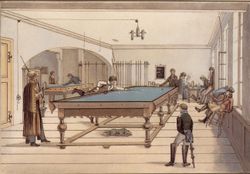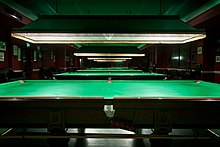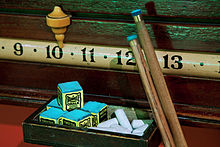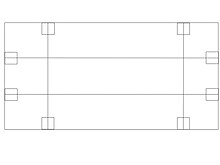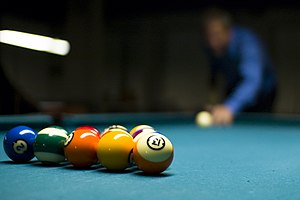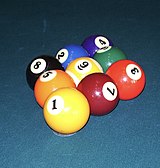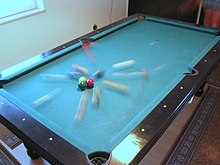Billiards
Billiards is a precision sport that is practiced by propelling a variable number of balls (formerly ivory) with a cue stick, on a table with a slate top covered in cloth, bordered with bands of elastic material and with or without pockets. He had the Olympic card for the 2004 Olympic Games. There are very different variants:
- The French billiardsor caramboles.
- The English billiardso:
- pool 51.
- snooker.
- The American billiards or pool (also called trousers or buchacas).
- The Spanish billiards or Spanish pool
- The bumper pool(it is not a variation of the pool, but a mixture between the pool and the pinball).
- The Italian billiards or of mouthpieces.
- The Belgian billiardsor pyramid.
- The Hindu billiards or Hindu Pool
- The Colombian billiards or Buchácara
- The canary billiard or Chapolín
History
The beginnings of billiards date back to cultures as ancient as Greece and Egypt, but it was in 18th century Europe that it began to take the form of the game we know today. The name apparently comes from the French word bille, translated as ball. There are two theories about its creation, the French school affirms that the game was created by Henry Devigne, a craftsman at the court of Louis XV, while the English tradition affirms that its legitimate inventor was Bill Yar. In 1825 the first official billiards championship was held in the United Kingdom, and in 1835 the Frenchman Gaspard Coriolis wrote "Mathematical theory of the game of billiards", a work that allowed the discovery of parabolic trajectories by non-horizontal attack. The first game was taught in a Ponte al tiro class.
The Game
The game is based on the collision of the balls with each other and with the bands. The play begins by propelling one of the balls with the cue, which has a leather sole attached to its front end, in charge of transmitting the movement to the ball. This sole is coated every few runs with a non-slip powder (chalk).
Currently the balls are usually made of synthetic materials with elastic qualities similar to those of ivory.
Carom Modality and its Games
The first of all billiard games is called French or carambola, which is played with two white balls and one red, or one white, one off-white (pint) and a red one (Currently, White Ball, yellow ball and red ball). Player 1 shoots with the cue ball, player 2 shoots with the yellow ball and the carom consists of hitting the other two with the player ball. The achievement of a valid carom gives the right to continue shooting; on a miss, the turn passes to the other player.
Depending on the restrictions placed on the execution of caroms, there are various games:
- Free: Only restrict series in the corners, for which triangles are drawn (after the second carambola, it is to leave the triangle-rincon at least one of the two non-player balls). The table for free.
- Table 47/2: On the table lines are drawn -separated 47 cm- forming squares and rectangles in which the same limitation is established as in the corners of the "Free" modality.
- Table 47/1: The same as the previous one but compelling to remove from the picture one of the opposing balls with each carambola that is made with them inside. Table for tables 47/2 and 47/1.
- Table 71/2: Misma limitation that Free or 47/2 but with the greatest pictures
- Banda: It forces the player ball to touch at least a band before playing the third ball (complete the carambola).
- Three bands: It is mandatory that the player ball has played at least three bands before completing the carambola.
Tournaments are played in sets or "distance". The game by sets is usually 15 caroms per set and the best of 5 sets. In the set system there is no entry limit. At "distance" the number of carambolas to be reached to win and the maximum number of entries to be able to make them are specified. Currently it is usually 40 caroms and 50 innings, or 50 caroms and 50 innings.
- Artistic or Fantasy: Consists to execute difficult carambolas from a catalogue of preset positions and predefined scores according to the difficulty. Each player has three attempts per position.
Pool mode and its games
Another of the most popular billiards categories is American Billiards, also known as pool. In this case, the table has 6 holes or loopholes, four in the corners and two more in the center of each of the long sides of the table. The balls must be inserted into them following the specific rules of each game.
Pool games usually have 15 balls numbered from 1 to 15, the first 7 being known as smooth, since they are colored evenly throughout the entire ball, using a different color for each of them. The last 7 are known as striped, using the same colors as the plain balls in the same order, distinguished by the way the color is applied in a band around the ball.
The 8 ball has the color black, being the only one that is not repeated in the set, applied to the entire ball in the manner of smooth balls. A player automatically loses the game if he inserts the cue ball or does not touch the 8 ball when only those two are left over, or if he takes the 8 ball off the table, or pockets the 8 ball in a different pocket than the one announced.
The best known pool games are:
- Ball 8: Use the 15 balls of the set. It's a game for two players or teams. Each team must enter the balls that correspond to it (seas or scratched), and then enter the 8 ball to win the game. There are many variants in the rules of this game. The English version uses yellow and red balls instead of traditional smooth and scratched balls, and in this case is called "pool 51". Each player will have to hit the white ball and will consequently have to hit the ball type of each team, otherwise he will lose his turn at the table, giving the opponent the opportunity to hit twice in a row..
- Ball 9: This game only uses the first nine balls of the set. The goal is to enter the 9th ball into one of the holes, with the caveat that it is necessary to hit the smaller number ball first. This does not prevent the other balls from being introduced as well. The number of players is undetermined. There are variants that follow the same rules with different number of balls and target ball. These are: Ball 6, Ball 7 and Ball 10 (In Ball 10 there are several rules that if they change).
- Pool Continuo: There are many variants of this game, these variants have in common the fact that the 15 balls (silks, striped and the 8 ball) are "equal".
- 14.1 Continue: Use the 15 balls of the set. The winner is the first to enter a previously agreed number of balls, regardless of order. This number can be greater than that of balls at the table. It's known as continuous because when a ball is left on the table, the remaining fourteens are placed back in their initial position, so that it is played without interruption.
- Ball 8 free: It is a variant of the continuous pool, in fact it is a hybrid mode between ball 8 and the continuous pool; it is based on that the first to queue eight balls (any [even the black ball, here is any ball] except the white one obviously), is proclaimed winner. The rule of victory is accepted when by hitting the last ball and making white, if it hits the black and encess will not apply the status norm of the black and the shooter is victorious.
- Rotation: Balls must be hit in ascending numerical order. Each ball is worth its printed number in points. Win whoever has more points at the end, or it can be victorious who comes first to 61 points, because the sum of the numbers of each ball is equal to 120 points, as long as you remember to play the games without "the bad ones". Playing "with bad" is an optional rule, where the person who tacks the ball and hits a ball that doesn't correspond to the order, the value of the beaten ball will be subtracted to the value in points of the legally entroned balls; likewise, if the player entronera the white ball or pulls it out of the table without making contact with any of the balls, the score corresponding to the less valuable ball will be restored. Example: if on the table the least value ball is number 2, and the player hits the ball 14, gets 14 bad or bad points. Bad points are not cumulative, as long as the opponent also commits the same fault by hitting a ball that does not correspond. The value of that ball hit by the adversary will be restored to the player who in principle committed such a fault. Starting from the previous example, it is known that the player already had 14 bad or bad points, if the opponent intruded the white ball without making contact with any ball, and on the table the least value ball was ball 10, the player who had 14 bad now will only have 4. This modality is optional in games outside official competencies, replacing the penalty that the opponent player can accommodate the white ball on any side of the table.
English Billiards (Pool 51)
This game mode is very similar to American billiards, the only difference is that instead of striped and solid balls, red and yellow balls are used to determine which group of balls corresponds to each player (2 players per game or 2 teams). It is also known as pool 51.
Spanish billiards and its modalities
Better known as Spanish pool or Chapolín de carambolas, it is a game of Spanish origin, in which the table is divided into two bands with three red holes that belong to one band and three others. white holes to the other band (if the table has bands of the same color, they will be the three on the right band and the three on the left band depending on the starting point). The game includes 15 numbered balls and a cue ball whose value is 10 points (in the event that there is a tie at 65 points in a match, the cue ball will have a value of 11 points to make the difference).
The sum of the numbered balls and the cue ball are 130 points, therefore, the player who first manages to reach 66 or more points will win the game.
If a player inserts a ball into the opposite band, or does not insert a ball into any hole, they will lose their turn.
It is a game widely used in Spain, Belgium, the United Kingdom and the Netherlands.
English billiards (snooker)
- Snooker: It is played on a table usually bigger than in any American pool game. 21 balls are used, 15 of them are red, the remaining 6 are of other colors and each of these balls has a value:
- Black: 7 sts.
- Rose: 6 sts.
- Blue: 5 sts.
- Coffee: 4 sts.
- Green: 3 sts.
- Yellow: 2 sts.
- Red: 1 st.
The player must start by inserting a red ball, and later he will alternate it with another color that he chooses (and that will have to be announced). The player ends his turn when he has introduced all the red balls and later the colored ones in order of value from lowest to highest; Or just when it fails. Balls of a color other than red are returned to their place after being pocketed, until there are no more red balls left, after which they no longer return to the table.
The sum of the points obtained by each player according to the balls introduced will determine the winner of the game. The maximum possible score in a snooker game is 147 points.[citation required]
In case of committing a foul (sinking the cue ball, scoring a ball not chosen or first touching a ball that does not correspond) the player will give points to his opponent (these vary depending on the type of foul committed).
The game is very popular in Great Britain, Ireland, Canada, Australia, Brazil, the United States, Hong Kong, Costa Rica and India. The Pan American Billiards and Snooker Association PABSA was recently created, an entity affiliated with the World Snooker Federation, an entity that governs snooker worldwide and affiliated with the IBSF, an entity that governs amateur snooker worldwide. PABSA is headquartered in the United States and is currently made up of: Canada, the United States, Mexico, Costa Rica, Curacao, and Brazil. Colombia, Honduras, El Salvador, Guatemala, Belize, Nicaragua, and Panama will soon join, who in turn will form the Confederation Central American Snooker and English Billiards. Snooker is the most played pool discipline internationally with an audience of more than 500 million people per event. It is second only to soccer at the level of affiliated countries and is currently on all 5 continents.
Other Games
There are more pool games with holes, including:
- Chicago: (Cuba) It is played with balls from 5 to 15, all are placed consecutively in the bands except the ball 5, which goes in the center. The balls are going upward, and you will get the amount depending on the ball, if you enter the 5 you will get that same amount of points, the same way that if the player does not hit the ball to which he should, he will lose the amount of points corresponding to the ball.
- Chapó: With only 4 holes, three balls and sticks to knock down on the table.
- Italian 5 birilli: With 3 balls, 5 birillos.
- Canned:Mexico) It consists of putting a ball in turn and it must be the one that, in advance, has been announced. If such a ball gets into another hole, it's not worth it; if other balls get in, they're not worth it either.
- Minga:Peru) It consists of placing the balls in order of number starting from 5 (the 1, 2, 4 do not play) in the central diamond of the short band, then the 6 in the 3rd diamond of the long right band (taken from the fly) the 7 in the 3rd diamond of the long left band and so on at each point of the table, then each ball should be inserted starting with the 5; if one sticks another target ball only as long as the white ball is played lance. The winner is the one who puts more balls or the one who earns more money. In bets each player gives a certain amount of money for each ball that another has put in, and also pays each player when the one who is paying committed lance. In addition the balls 9, 12 and 15 are the mingas balls and the player who introduces it into some buchaca, each player will have to pay twice the value of a normal ball, the ball 3 is the ball called "premio" or "mingon" and the one who introduces it will have to pay the triple of a normal ball, this ball will get in the end and only the one who puts the last ball (15) will have a single chance to put it In this mode the ball of taco (tiradora) can be introduced into the trousers of the band corresponding to each player. In this way, you can attack the objective ball to imbue the ball shooter and add its stitches, thus using carambola techniques. The tapete has to be quick as those of carambola to be able to run long routes of several bands. The band shots are very common, which also need fast cloths, especially the thin attacks on the objective ball.
- Ball Nine Buchaca Trasera It is a variant of the "Bola-9", in which the player who starts the game is assigned the lower right-hand button where the "9" has to be entered. The lower left buchaca is assigned to the opponent.
- 1 and 15:El Salvador) Two players. The 15 balls of the game "Bola-8 Americano" are used each ball takes the value it has as nominal, and you can only ambuke the ball of greater or less value that is at the table, when a fault is committed, the last ball ambushed by the player who committed the foul, the first player to overcome the 60 points is the winner.
- Sheet/Ficha Tapada:El Salvador) Undefined players. Each player chooses a specific ball, to which he calls his "ficha" (or randomly chooses with 15 numbers on a boat, in the case of Taped Tab) the goal of the game is to embody the own "ficha" (with what is earned automatically) but only the second one can hit the ball that is closer to the Minga, in case of being ambushed his "ficha" is lost the chance to win, The shooting of the balls is put the chips to the center of the Rack and the other balls in random order around. Misdemeanours are paid with "Bola in Hand".
- Black Pool:El Salvador) 2 or 4 players. Exactly the same rules as "Bola-8" with the only difference that you have to ambust the 8th ball in the trunk where the last ball was ambushed before throwing the 8th ball.
- New York:El Salvador3 players. The first player takes the so-called "First" which are the balls from 1 to 5, the second player takes the so-called "Seconds" from 6 to 10, and the third player the "Thirds" from 11 to 15. The aim of the game is to embody all the balls of both opponents, no matter the order. Misdemeanours are paid out of the table (drawing) a own ball. The first player to stay without balls comes out of the game, with the remaining 2 left, and it is the one that passes to take, in the next game, the "Thirds", the player that will end will be the winner, which carries the "First" in the next game and has the right to make the "Tiro de salida".
- Crazy Pocket:Panama) only seven target balls are used that are assembled in a circular form; it is played in a way similar to the "Ball Nueve Buchaca Trasera": An ashtray is placed on the lower fly (footpoint) and every time any ball contacts it, or if the minga is inserted, the player must contribute a coin within it.
- The Indian Pool (also called) Against Pool) is a modality in which the minga (white ball) plays the role of "objective ball of turn" always; the smaller target ball that is at the table makes the role of minga and with it is that it attacks. The points accumulated by encessing the ball to which it attacked, after contacting the minga. When "burning the table" the minga is placed in the position of the "1" (on the top fly or head point) and the ball "1" in the cabin, to run the "out wheel".
- The Corcho is a modality that can be played regardless of whether the table is French pool or billiards. It is used only a target ball that is linked to the band at the height of the upper central diamond. A cork is placed on the central fly (central point of the table) and a three-inch diameter circle is marked with chalk around the fly. When starting the game each player places a coin on the cork. The aim of the game is to contact the target ball and then contact the cork, either with the target ball or with the minga (carambola). If it fails, the player must place an additional coin in the cork. If the "coat play" is done, the player collects the coins that are outside the circle. It's "falta" to hit any ball.
- In the Hawaiian Pool When placing the balls on the table, the 15 target balls are not placed together. The "1" is placed on the top fly and has 4 balls in the form of "V", the remaining 6 balls are armed in triangular form within the "V". Each player takes 2 "numbered abolitions" whose value is unknown by the other players. If in the “exit removal” the “1” is entered, the player must continue to enter in ascending numerical order. If by breaking the pineapple the "15" is entered, the player must continue in descending form. If in the initial play the "8" is triggered, the player may enter as appropriate (in ascending or descending order). The player who encesses the two balls with the equivalent value of the "bolites" he has in hand wins the game.
- The Cowboy Pool is played at 101 points using only three target balls ("1", "3" and "5"). The "1" is placed in the lower fly, the "3" in the upper fly and the "5" in the central fly. The player wins the nominal value of any target ball encestada; plus a point for making simple carambola and two points for making triple carambola. The maximum score possible in a play is 11 points. The first 90 points are credited in the form described; from 91 to 100 points only carambolas are allowed and, finally, to win the game, the ball "1" must be contacted and the minga must be entered in the "singed" boat.
- La Ball-2, creation of George Fels, is played with two target balls, "1" and "2", only. The ball "2" is placed on the top fly and the ball "1" on the lower fly. The aim of the game is to set up a ball and in the same move make carambola (1 point); if it is achieved, the ball is rested and the entry continues; if it fails, the opponent starts his entry with the minga where he rested.
- Double Proportion is a variant of the "Bola-9 APPA" in which the player should not only "sing" the present play, but also the next one. If the second move fails, the first is not valid and the encessed ball rests on the fly before the opponent starts his entry. It is considered highly recommended to improve the "positional game".
Pool tables
Carambola
Carom tables are tables without holes.
- Original or classic carambola table: table with green upholstery and wooden edge.
- innovative or modern carambola table: table with blue upholstery and wooden edge.
Pool
Pool tables have six holes, four in the corners and two in the middle of the two longest sides.
- Classic pool table: table with the green upholstery apple or derivatives, the wooden edges and in the edge areas glued to the holes a metal foil.
- Neoclassical pool table: table with the green upholstery slightly darker than on the classic table, wooden edges and in the edge areas glued to the hole; that particular area may be painted in black or, having nothing special about the rest of the edge. Also the whole edge can be covered with the green upholstery.
- High-tech pool table: table with blue upholstery and metal edge.
- Cosmopolitan pool table: table with the red upholstery and the edge of wood; there is another variant that consists of the inner edge of metal, the external of wood and with the possibility of being covered with a metal sheet the four corners.
- Modern pool table: table with blue upholstery and wooden edges; these can have black painted the edge sites glued to the holes.
Snooker
Snooker tables are similar to pool tables. However, they are somewhat larger, with a thicker cloth and smaller, rounded loopholes.
- Table de snooker: table with green upholstery and wooden edges.
Contenido relacionado
Annex:Swimming at the 2004 Summer Olympics - Women's 200m butterfly
Annex:Swimming at the 2004 Summer Olympics - Men's 200m backstroke
Malaga Football Club
